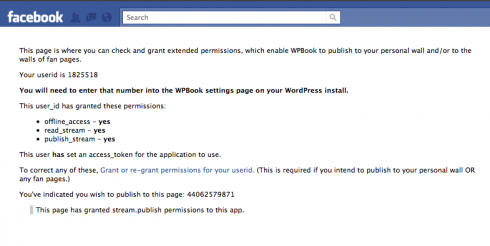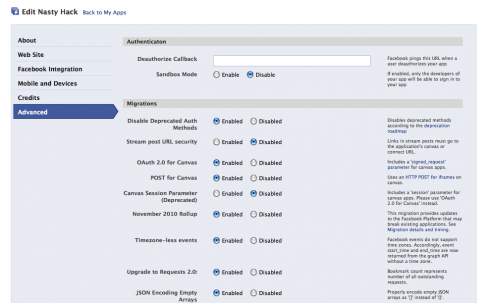I’ve just tagged earlier today a 2.1b1 (beta 1) release of WPBook. Please download it and test it, and report back what you find here or (preferably) in the forums.
Make changes to your Facebook Application settings described below after installing WPBook 2.1 but before trying to visit application pages!. We’ll update the official WPBook documentation once we’ve got a few folks testing the new version and can move to a 2.1 release.
This release is the first to use Facebook’s OAuth-based authentication protocol, Graph API, and new PHP SDK. I know that’s a whole lot of acronyms, but let’s just say it means we’ll stay current as Facebook makes obsolete some of the older ways of integrating to Facebook.
New features:
- Facebook Like button on posts, rather than Share button. The like button now works in a very similar fashion to the older share button (it posts into the users news feed when he/she likes something). It also resolves to the external url, so if you’re using a Facebook Like button on your blog outside Facebook, likes inside Facebook will get counted as well.
- iFrame based tabs. Unlike the old FBML based tags, iFrame based tabs (which you can use on “new” page profiles) can include videos and other full html objects.
- WPBook now uses post_thumbnails (“featured image” set in the post edit screen) for wall posts, which should yield more consistent results
- WPBook now requires WordPress 2.9 or later
In other words, this is really mostly a back-end cleanup release.
When you install, you’ll need to make a number of changes:
- In WPBook Settings, there’s now a box for “App ID” rather than “API-key.” You’ll need to change this as if you had WPBook before 2.1, it will be set to your API Key – you’ll need to change it to your App ID
- In WPBook Settings, go into the Stream/Wall section, make sure your Profile ID and Page ID are set correctly, and click on the Check Permissions link. Even if you previously had permissions set correctly, you’ll need to re-grant them in order to store successfully an access token that will give WPBook the ability to connect to Facebook even when you are offline. The Check Permissions page itself (shown inside Facebook, see below) now tries to give an indication of the current status of all permissions and necessary steps.
- Update your Facebook Application settings – go to your Facebook application and change the Advanced Tab settings to match the below – enabling OAuth 2.0 and Post for iFrames Canvas urls
- Update your Facebook Application settings for Page Tabs. If the page you want to add the tab to is using the old page style, leave tabs set to FBML and
?app_tab=true&fb_force_mode=fbml(as before). But if the page to which you want to add the tab is using the new profile layout, change tabs to iframe, and change the tab url to?app_tab=true, leaving out the&fb_force_mode=fbmlbit.
Here’s what the new “Check Permissions” page looks like:

And here’s what the “Advanced” tab of your Facebook Application settings should look like for 2.1 or later:

I’ve validated that it is working for me on two different WordPress blogs (with different Facebook Applications):
- Posting to individual profile Wall on post publish, including featured image
- Posting to Application Profile Wall, Page Wall, and Group Wall, including featured image. (One type of wall at a time – is there interest in posting to multiples at once?)
- Importing comments from individual profiles and from page walls – based on wp-cron, running hourly
- Showing canvas pages with new OAuth based permissions
- Showing iFrame based tabs or FBML based tabs, depending on the string entered in the url box of the Facebook settings for Tabs – iFrame based tabs only work on new style profiles


When creating a new post, I get this error:
Fatal error: Call to undefined function get_the_post_thumbnail() in /var/www/knife-depot.com/blog/wp-content/plugins/wpbook/includes/publish_to_facebook.php
@steve – two options.
1. Enable support for post_thumbnails in your theme
2. Update to 2.1.1
If you choose option 2, just note that you will not be able to use post thumbnails to select the image to post to the FB wall.
See http://wordpress.org/support/topic/plugin-wpbook-21-released and other threads in the forums
hey john, thanks for the reply. I got past this error but still cannot have the posts appear on my facebook wall, even though the permissions are correct. One strange thing is that my facebook app settings look different from yours. More info here: http://wordpress.org/support/topic/plugin-wpbook-post-for-iframes-canvas-urls?replies=5